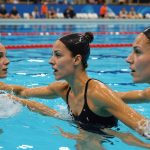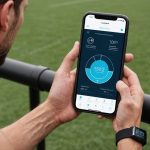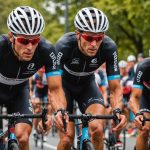Understanding Endurance in Rowing
Endurance in rowing is the ability to sustain high performance over long distances, which plays a critical role in long-distance competitions. This crucial aspect of rowing performance is not purely about maintaining physical strength but involves intricate physiological and mental components that work together.
Physiologically, rowing harnesses the energy systems in our body, requiring an efficient conversion of nutrients into energy, allowing the muscles to perform prolonged activity without rapid fatigue. Key elements include cardiovascular efficiency, muscular endurance, and the ability to metabolize lactate. Regular long-distance training enhances these abilities, making endurance a pivotal trait for competitive rowers.
Have you seen this : Mastering the art of spins: elevate your ice skating with targeted strength training strategies
On the mental side, enduring gruelling practice sessions and long races necessitates mental fortitude. Rowing performance improves when athletes develop determination and focus, training their minds to remain resilient under pressure. Strategies like visualization help athletes maintain concentration and push through physical discomfort.
Thus, a comprehensive understanding of endurance in rowing amalgamates both of these integral components. This holistic view ensures that athletes can excel during competitions, meeting the demands of their sport through meticulously designed training and mental preparation.
Also to read : Exploring the Impact of Barometric Pressure Changes on Skydiving: A Comprehensive Aerodynamics and Altitude Analysis
Understanding Endurance in Rowing
Endurance is crucial for achieving peak rowing performance, especially in long-distance events. At its core, endurance is the athlete’s ability to sustain physical activity over extended periods, crucial in enduring the rigorous demands of rowing.
In long-distance competitions, endurance distinguishes exceptional rowers by enabling them to maintain high performance without compromising speed or technique. It offers the competitive edge necessary to push through challenging conditions, where fatigue is a common adversary.
The physiological aspects of endurance involve cardiovascular efficiency, muscular strength, and stamina. Rowers require a heart and lungs capable of delivering ample oxygen to muscles, which endure repetitive contractions. Regular long-distance training enhances cardiovascular capacity and muscle endurance, reducing the risk of premature fatigue.
Beyond physicality, the mental component of endurance is equally vital. Rowers must cultivate mental resilience, concentrating on sustaining optimal performance despite physical discomfort. Mental endurance enables athletes to push boundaries, setting personal records and achieving ambitious goals.
By understanding and developing both the mental and physical aspects of endurance, athletes enhance their overall rowing performance, positioning themselves for success in long-distance competitions.
Training Techniques to Enhance Endurance
Endurance is vital in rowing, and training strategies play an essential role in building it. Endurance workouts must be specifically tailored to challenge and expand a rower’s cardiovascular and muscular capabilities.
Interval Training for Rowers
Interval training is renowned for its effectiveness in building endurance. Short, high-intensity bursts followed by rest can significantly improve rowing performance. For instance, rowers might engage in 500m sprints with a rest equivalent or custom duration. This method taxes both aerobic and anaerobic systems, ensuring a comprehensive fitness regimen.
Long Steady-State Rows
Steady-state rowing is another cornerstone in endurance training, involving more prolonged, consistent sessions that focus on maintaining a moderate pace. To embody the benefits, rowers should aim for sessions lasting 45-90 minutes, intertwining them within weekly training schedules for substantial progress. This technique is excellent for increasing cardiovascular efficiency and muscle endurance.
Cross-Training Options
Integrating cross-training into routines offers additional endurance benefits. Activities like cycling, swimming, or running can complement rowing workouts by reducing monotony and addressing different muscle groups. Striking a balance between rowing and cross-training diversifies workouts, aiding in the overall development of rowing-specific endurance.
Training Techniques to Enhance Endurance
To achieve optimal endurance in rowing, implementing targeted training strategies is essential. Tailored endurance workouts and specialized rowing drills can significantly boost rowing performance.
Interval Training for Rowers
Interval training emerges as a powerful technique, particularly in enhancing aerobic capacity. Alternating between high-intensity and lower-intensity rowing bursts helps build endurance more effectively than constant speed sessions.
Sample workouts might include:
- Five-minute high-intensity rows followed by two-minute rest intervals
- 10x500m sprints with minimal rest in between
These specific drills enhance cardiovascular efficiency over time, making them indispensable for rowers aiming to maintain a competitive edge in long-distance competitions. Progress can be measured by tracking improvements in split times or overall endurance capacity. Regular adjustments are beneficial based on performance data and personal goals.
Incorporating these endurance workouts into a training regimen ensures that rowers are better equipped physically and mentally for competitive challenges. This strategic approach to training builds essential speed and stamina, supporting success in long-distance rowing events.
Nutrition Strategies for Optimal Endurance
When striving for peak endurance in rowing, nutrition plays a pivotal role. Nutrition for athletes not only fuels performance but also aids recovery, making it indispensable for long-distance rowers. Ensuring a balanced intake of key nutrients such as carbohydrates, proteins, and fats intensifies athletic output. Carbohydrates are crucial for energy, proteins support muscle repair, and fats offer a sustained energy release.
Timing Meals and Snacks
Strategically timing meals around training sessions can elevate performance. Consuming a carbohydrate-rich meal approximately 2-3 hours before rowing optimizes glycogen stores. Quick, easily digestible snacks or energy gels might be included just before intensive workouts or competitions to avert dwindling energy levels, thereby enhancing fueling endurance.
Hydration Tips and Strategies
Effective hydration is another cornerstone in sustaining rowing performance. Drinking small quantities of water or electrolyte-infused beverages regularly prevents dehydration, which can dramatically impair both physical and mental capabilities. Monitoring urine color—aiming for a pale yellow—provides an easy hydration metric.
This methodological approach to nutrition ensures that rowers maintain a robust, responsive body, essential for maximizing efficiency and success in their rowing endeavors.
Nutrition Strategies for Optimal Endurance
Nutrition is paramount for athletes, playing a critical role in fueling endurance and ensuring optimal rowing performance. A well-structured rowing diet focuses on providing the body with essential nutrients and energy for long-distance training.
Key nutrients, such as carbohydrates, are vital for endurance athletes. They serve as the primary energy source during prolonged rowing sessions, allowing rowers to maintain a consistent pace and reduce fatigue. Proteins are equally important for muscle recovery and repair, supporting endurance maintenance.
Timing meals and snacks around training can make a significant difference. Consuming easily digestible carbohydrates and proteins about 1-2 hours before training helps in maximizing energy levels. Additionally, post-training meals rich in nutrients help replenish glycogen stores and expedite recovery, preparing the body for subsequent sessions.
Hydration is another cornerstone of endurance training. Adequate fluid intake before, during, and after rowing helps maintain performance levels and prevents dehydration, which can severely impact training outcomes. Athletes should aim for consistent hydration throughout the day, adjusting based on intensity and duration of their workouts.
Implementing these nutrition strategies can significantly enhance endurance in rowing, ensuring athletes maximize their performance during competitions.
Recovery Methods to Maintain Endurance
Balancing rigorous training with effective recovery techniques is essential for athletes to maintain peak endurance. Proper muscle recovery supports sustained performance in rowing, preventing injuries and promoting overall well-being.
Active Recovery Principles
Active recovery emphasizes low-intensity exercises, facilitating muscle repair without exhausting the body. Effective methods include light rowing, stretching, and yoga, which keep muscles engaged while promoting circulation. Incorporating active recovery days into training plans helps prevent burnout, maintaining endurance levels consistently.
Role of Sleep in Recovery
Sleep is a cornerstone of endurance maintenance, profoundly influencing recovery and performance. For athletes, obtaining quality sleep optimizes muscle repair and ensures mental sharpness. To enhance sleep, establish a regular sleep schedule and create a calming bedtime routine. Prioritizing rest leads to improved endurance and reduced fatigue.
Listening to Your Body
Understanding the body’s signals is crucial in balancing training and recovery. Signs of overtraining, such as persistent fatigue or decreased performance, indicate a need for rest. Strategies like scheduling regular rest periods and adjusting training intensity aid in preventing overuse injuries. Consult professionals if symptoms persist, ensuring a focused approach to endurance maintenance.
Recovery Methods to Maintain Endurance
Effective recovery techniques are crucial for maintaining endurance and improving rowing performance. By prioritizing recovery, athletes can ensure their bodies remain robust for sustained long-distance training.
Active Recovery Principles
Incorporating active recovery into training allows athletes to promote muscle recovery without complete rest. Exercises like light rowing, cycling, or swimming at a gentle pace can help to maintain cardiovascular function and flush out metabolic waste. Structuring recovery days with lower-intensity activities aids in rejuvenating muscles, reducing soreness, and preventing overtraining.
Role of Sleep in Recovery
Quality sleep significantly influences endurance, as it facilitates physical and mental restoration. Athletes should aim for consistent sleep patterns, optimizing recovery and overall performance. Techniques for improving sleep include maintaining a calm pre-sleep environment, limiting screen exposure before bed, and ensuring a regular sleep schedule for effective endurance maintenance.
Listening to Your Body
Recognizing signs of overtraining is essential for endurance athletes. Symptoms like persistent fatigue, decreased performance, and heightened injury risk indicate a need for intervention. Strategies to incorporate rest include alternating hard and easy training days and periodic rest phases. Seeking professional advice when needed ensures personalised training adjustments, keeping athletes at their peak.
Mental Preparation for Endurance Events
Preparing mentally for endurance events is paramount in rowing, where mental strategies bolster performance in long-distance rowing. Mental toughness allows athletes to push beyond physical limits, ensuring sustained rowing performance.
Visualization Techniques for Race Preparation
Visualization is a powerful tool that athletes can leverage to enhance their race mindset. By mentally rehearsing successful strokes and outcomes, rowers solidify a positive competition mindset. This practice enables them to anticipate race challenges, improving endurance and readiness for unexpected conditions. Visualizing a detailed race day, from start to finish, can help reduce anxiety.
Strategies to Manage Race-Day Anxiety
Managing race-day nerves is crucial for optimal competition performance. Breathing exercises and mindfulness techniques foster a calm state, enhancing focus and reducing anxiety’s impact. Mental rehearsal of running through potential scenarios in the race can mitigate nervousness, preparing rowers to adapt swiftly. Post-competition reflection aids in developing these strategies further, refining the athlete’s psychological approach for future challenges.
Incorporating these mental techniques ensures athletes are psychologically primed for endurance events, amplifying both preparation and competitive outcomes. Consequently, integrating these strategies into training regimens fosters an unyielding endurance psychology, equipping rowers to face long-distance challenges with resilience.
Mental Preparation for Endurance Events
Mental strategies play a pivotal role in enhancing endurance and achieving peak rowing performance. Cultivating a robust competition mindset equips athletes to handle the pressures of long-distance events.
The significance of mental toughness cannot be overstated. It enables rowers to persevere through physical and mental challenges, ensuring consistent endurance throughout a race. Developing this resilience involves reinforcing focus and determination during training, allowing rowers to adapt to high-pressure environments.
Visualization Techniques for Race Preparation
A vital component of mental endurance is visualization techniques. By mental rehearsing race scenarios, rowers can condition themselves to anticipate and navigate difficulties with composure. Visualization aids in refining technique, improving confidence, and solidifying a competitive mindset.
Strategies to Manage Race-Day Anxiety
Race-day anxiety is a common hurdle, yet manageable by employing effective mental strategies. Techniques such as deep breathing, positive self-talk, and establishing a pre-race routine can mitigate anxiety. These practices enhance mental clarity, ensuring athletes capitalize on their training and innate capability.
Incorporating these strategies into training allows rowers to harness endurance psychology for optimal performance. Being mentally prepared ensures athletes are not only physically ready but also emotionally equipped to excel in competitive rowing environments.
Competition-Day Strategies
Race preparation is vital for optimising performance and mastering rowing tactics. Formulating a comprehensive strategy ensures seamless execution under race conditions.
Pre-Race Routine
A personalized pre-race routine primes athletes for success. Begin with a light warm-up to enhance blood flow and flexibility, crucial for avoiding early fatigue. Include mental focus exercises, such as deep breathing or mindfulness, to center and calm the mind, reinforcing a competition mindset. Essential components like checking equipment and reviewing race goals should conclude the routine, fostering confidence.
In-Race Nutrition and Hydration
Sustaining energy during competitions hinges on strategic nutrition and hydration. Consuming easily digestible snacks during short breaks can maintain vigor. Energy gels offer a quick nutrient boost during intense phases. For hydration, small, frequent sips of electrolyte-rich fluids are best to avert dehydration without overloading the stomach.
Post-Race Recovery Essentials
Post-race recovery initiates with well-timed nutrition and hydration. Consume a balanced, nutrient-rich meal within 30 minutes to replenish glycogen stores. Engaging in gentle stretching is critical for reducing soreness and promoting muscle recovery. Planning long-term recovery involves monitoring overall well-being and adapting future training strategies to maintain peak endurance after each event.
Competition-Day Strategies
Excelling in rowing requires meticulous race preparation and effective competition strategy. Establishing reliable rowing tactics can position athletes advantageously during races.
Pre-Race Routine
A pre-race routine is essential for priming athletes mentally and physically. Personalising this sequence boosts confidence and ensures readiness before a race. Important elements include dynamic stretching to increase blood flow and enhance flexibility, along with mental focus techniques to reinforce concentration. Visualising race strategy is key to navigating the upcoming challenges. These components collectively set the foundation for successful rower performance.
In-Race Nutrition and Hydration
Sustaining energy levels throughout a race hinges on strategic nutrition and hydration. Consuming easily digestible energy gels or bars during the race replenishes glycogen stores, ensuring consistent power output. Hydration is equally critical; sipping small amounts of water or electrolyte drinks maintains fluid balance and prevents dehydration, essential for competitive rowing.
Post-Race Recovery Essentials
Immediate action post-race significantly influences recovery. Prioritise nutrient-dense meals rich in carbohydrates and proteins to accelerate muscle repair and energy replenishment. Implementing a thorough cool-down procedure through light rowing or stretching aids in reducing muscle stiffness. Long-term recovery strategies focus on repairing body tissues, optimizing conditioning for future events. These post-race actions sustain endurance and enhance overall athletic longevity.











